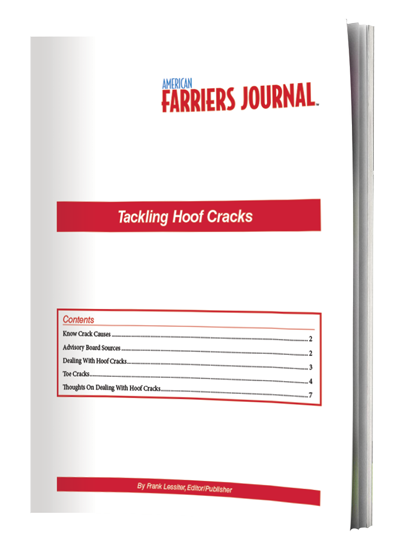
Nearly 90% of quarter cracks in performance horses are related to hoof balance concerns. The other 10% are due to a pathological incident that somehow compromised the hoof wall.
In reality, there’s no simple answer for effectively dealing with various types of hoof cracks. And that’s why we’re offering you the best ideas used by a half-dozen veteran farriers in a new American Farriers Journal in-depth eGuide on “Tackling Hoof Cracks.” It’s jam-packed with field-tested ideas you can immediately put to good use when dealing with all aspects of hoof crack repair and prevention. And it’s FREE!
Dear Hoof-Care Professional,
Devastating hoof cracks can occur anywhere on the hoof wall and lead to serious downtime for any horse. Whether they’re short-lived or chronic, most hoof cracks can be blamed on improper mechanics, environmental extremes or serious pathology concerns.
Know The Causes Of Cracks And How To Deal With Them.
Coming up with an effective maintenance and prevention program starts with zeroing in on the mechanical forces that led to the crack in the first place. This means properly evaluating the horse’s conformation for angular limb deformities, rotational limb deformities, club feet or long/low heel situations. It means deciding what may have caused the crack in terms of the environment, nutrition, how the horse is worked, breakover, the timetable for getting the horse back to work and deciding whether the owner can deal with the situation.
In regard to the horse’s mechanics, this means determining where the hoof load is landing and where the load is located during the weight-bearing phase. Radiographs of hoof crack cases certainly can be a big help when it comes to analyzing the shape of the P3, P2 and P1 bones, joint spaces, digital breakover, sole depth, the palmar angle and even the horn to lamellar distance.
Once you’ve evaluated the crack, the next step is to figure out how to reduce the load and deal with whatever forces are causing the problem with the goal of accelerating foot growth and reestablishing soundness. Once the foot starts to gain mass and the crack begins to grow out, a maintenance strategy is needed that will keep the horse sound and hopefully avoid future hoof crack worries.
For this Hoof-Care eGuide, six American Farriers Journal Editorial Advisory Board members contributed thoughts, insights and field-tested ideas from their own experiences on dealing with hoof cracks. They came up with solid answers to a dozen questions dealing with different aspects of hoof cracks that you can put to use the next time you run into a serious hoof crack situation.
But wait there’s more!
Besides offering remedies for dealing with hoof cracks, this FREE eGuide also offers step-by-step photo sequences so you can see first-hand what these half-dozen veteran farriers are recommending.
The valuable hoof crack insights from these veteran farriers deal with specific instances, such as a crack growing down from a damaged coronary band with scar tissue or a hoof with poor integrity that starts at the coronary band and moves downward on the hoof. With cracks that begin at the coronary band and grow downward, a major cause is unequal weight bearing, which may lead to a conformation defect, poor foot prep by the farrier or relying on the wrong shoe to overcome the specific defect.
Answers to all 12 hoof crack questions offer valuable techniques from top-notch farriers.
While this discussion of problem cracks centers around the use of various materials and techniques for stabilization and repairing hoof cracks, this eGuide points out that none will likely be successful over the long term unless the cause of the hoof wall defect is immediately determined and addressed with basic farriery techniques.
For instance, a full-thickness quarter crack is almost always associated with a sheared heel conformation where an excessive load has been placed on one heel-quarter or heel relative to the other side of the foot.
When a full-thickness toe crack starts at the coronet, you’ll normally find a long toe/low heel conformation with an excessive bending force on the toe or an upright or club foot that leaves an excessive load on the dorsal part of the foot.
To overcome these concerns, you’ll need to address the hoof capsule distortion in order to redistribute the load on the solar surface of the foot. By doing so, you can alter the forces on the section of the foot containing the defect. Yet in this situation, the best advice may be to advise the owner to pull the horse out of competition for a month or more to rest the hoof and crack.
It’s critical to be able to recognize how cracks start and expand. As you work with these situations, you’ll find significant differences between cracks that get their start at the bottom of the hoof and work their up the hoof compared with cracks that work in the opposite direction.
There are no easy answers. Let this report provide you with valuable insights and techniques to make the job of tackling all kinds of hoof cracks much easier.
Yours for better hoof care,
What new insights did you gain from this eGuide? What jumped out at you?
Share your observations below.



Post a comment
Report Abusive Comment